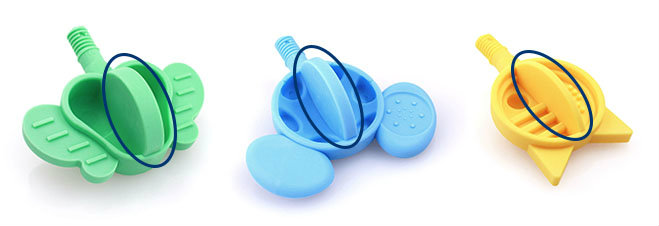How to Practice Vowels & Jaw Heights
Posted by Debra C. Lowsky, MS, CCC-SLP on 29th May 2018
Question: Can the bite blocks on the back of the animal tips be used to practice vowels?
I usually use the bite blocks on the back of the Animal Tips as a jaw grading exercise for feeding purposes (for individuals to practice gauging how far to open the mouth for food). But they can certainly be used to work on jaw grading for vowel sounds too. Assuming you are an SLP, this is what I would do:
I would use the standard vowel chart and go through the vowels according to how each is produced, such as front, central, back, etc. Say the sound to yourself, placing each tip up to your mouth to see which height corresponds with which sound.
.

.
For example, for the production of a short "a" (as in "sat"), the thick bite block on the back of the Dog Tip is the perfect height.
For "uh" (as in "but"), the thinner bite block on the back of the Mouse Tip would be best, because the mouth doesn't open as wide.
For a long "eee" (as in "eat"), the even thinner bite block on the back of the Cat Tip would be best, because the jaw opens only a little bit.
And so forth. Then to practice each sound, have the individual bite down on the bite block and prompt them to say the corresponding sound/vowel.
.

.
In addition to the bite blocks, you can also have individuals bite down on other parts of the Animal Tips too (the cheeks, ears, face, etc.) for different jaw height options. Or you can do the same with really any oral motor tools that you have. For example, I often like using the Y-Chew, as each "arm" has a different width/thickness.
On an important related note, to teach vowels, you may also need to teach jaw stability and tongue and jaw dissociation. Have the individual bite down on the bite block, and as he/she sustains the bite, have them say tongue tip sounds (/t/d/n/l/), back of tongue sounds (/k/g/y/), etc. Biting down stabilizes the jaw and forces the tongue to do all of the work without any assistance from the jaw.
Of course, vowels and jaw heights depend on the size/age of the individual as well as their accent and where he/she is from.
Last but not least: I have personally found the book Vowel Tracks by Pam Marshalla to be very helpful. It spells out vowel development and has a very helpful vowel chart.
I hope you find this helpful!
Debbie
Debra C. Lowsky, MS, CCC-SLP
.
